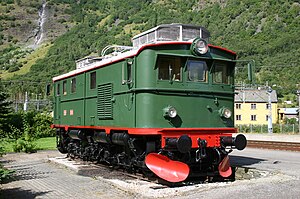NSB El 9
El 9

|
|
|
|
|
| Performance figures |
| Maximum speed |
60 km/h (37 mph) |
| Power output |
712 kW (955 hp) |
| Tractive effort |
108 kN (24,000 lbf) |
|
| Career |
| Operators |
Norwegian State Railways |
| Number in class |
3 |
| Numbers |
2062–2064 |
| First run |
1947 |
| Disposition |
Retired; two preserved, one scrapped |
|
| Performance figures |
| Maximum speed |
60 km/h (37 mph) |
| Power output |
712 kW (955 hp) |
| Tractive effort |
108 kN (24,000 lbf) |
| Career |
| Operators |
Norwegian State Railways |
| Number in class |
3 |
| Numbers |
2062–2064 |
| First run |
1947 |
| Disposition |
Retired; two preserved, one scrapped |
NSB El 9 is a retired class of three electric locomotives built by Thune for the Norwegian State Railways (NSB), with electrical equipment from Norsk Elektrisk & Brown Boveri (NEBB) and Per Kure. The locomotives were delivered in 1947 after a three-year delay caused by wartime sabotage in response to the German occupation of Norway. They were used nearly exclusively on the Flåm Line and Hardanger Line, two steep branch lines. The units were used on the Flåm Line until 1983, when they were replaced by El 11. They were then used as shunters until being retired in 1988. Two of the locomotives have been preserved.
The class was custom-made for steep hills and slow speeds; it featured a low 48 tonnes (47 long tons; 53 short tons) weight which, with a Bo'Bo' wheel arrangement, allows for a 12-tonne (12-long-ton; 13-short-ton) axle load. This made the locomotives only 10.2 meters (33 ft) long. They had a power output of 712 kilowatts (955 hp), a tractive effort of 108 kilonewtons (24,000 lbf) and a maximum speed of 60 kilometres per hour (37 mph). They were given road numbers 2062 though 2064.
With the construction of the Bergen Line, which was completed in 1909, it was decided that there would be built branch lines to two fjords, the Hardanger Line to Hardangerfjord and the Flåm Line to Sognefjord. Both branches were steep and curvy, which set high demands on the locomotives. The Hardanger Line was 27.45 kilometers (17.06 mi) long, had a maximum gradient of 4.5 percent, a minimum curve radius of 180 meters (590 ft), and a maximum speed of 40 km/h (25 mph). The Flåm Line is 20.20 kilometers (12.55 mi) long, had a maximum gradient of 5.5. percent, a minimum curve radius of 130 meters (430 ft) and a maximum speed of 40 km/h (25 mph) uphill and 30 km/h (19 mph) downhill. Both lines had a maximum permitted axle load of 12 tonnes (12 long tons; 13 short tons), standard gauge and a 15 kV 16 2⁄3 Hz AC electrification system. The Hardanger Line opened in 1935 and the Flåm Line in 1940, although the latter did not receive electric traction until 1944.
...
Wikipedia

